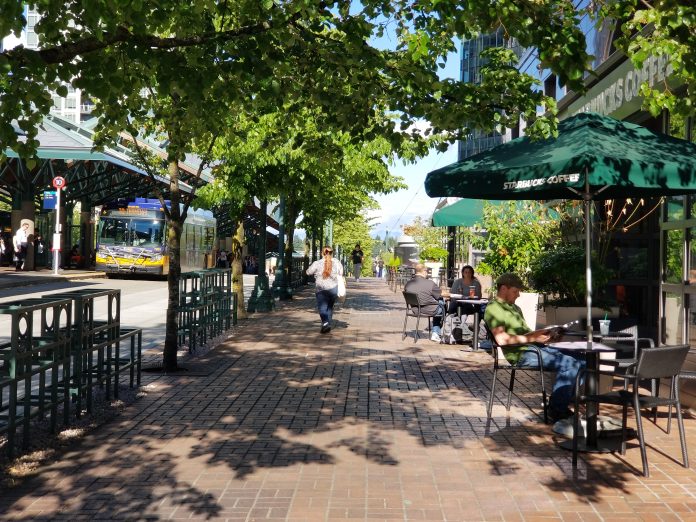Bellevue Grand Connection is a once-in-a-lifetime opportunity. How do we get the most out of it?
Downtown Bellevue is amidst its biggest growth spurt over the past 10 years. The Seattle Times identified it as the region’s second-fastest growing neighborhood after South Lake Union. Its population increased by a whopping 73% from 2010 to 2017. Its population density sits at 18,000 people per square mile, which is nearly identical to South Lake Union. Combine that with the fact that about 40% of downtown Bellevue is ripe for redevelopment and one can imagine how the population and density will double once more.
What can we expect from all of this? Certainly an increase in the number of people walking the streets. And that’s a good thing—more people make for a livelier and safer space. But one of the common remarks people make about Bellevue, especially when coming from Seattle, is that it is not very pedestrian-friendly. Wide and loud streets like NE 8th St make for an alienating place that few people want to hang around and indeed 8th gets few pedestrians.
Luckily, the City of Bellevue has recognized this unmet need and is working on a plan for an improved pedestrian link for the city’s key amenities—the downtown parks, shopping destinations, transit infrastructure, and trails system—all amid major office and residential buildings. This is known as the Bellevue Grand Connection and even includes ambitious plans for a lid over I-405.
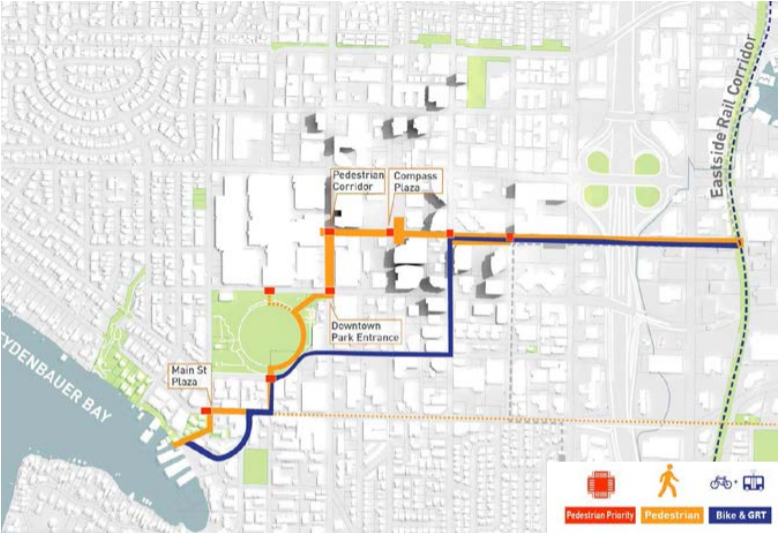
Goals for the Street
This is truly visionary thinking on behalf of Bellevue city planning—every city needs to have a central public space—where friends and family meet, business meetings can occur, or people can do some of their errands. This can form the heart of the neighborhood that people identify with.
Now, of course Bellevue has a number of great streets like Main Street and Bellevue Way, but the central core of downtown going east-west is really missing that. So the Grand Connection effort aims to fill that gap.
What can we expect to do in such a space?
- Dining – Restaurants and coffee shops are the most common places people meet and are key to enabling community. It is also a source of constant foot traffic that is essential to the success of this corridor.
- Retail – Bellevue is the largest shopping destination on the Eastside and any retail on a high pedestrian traffic street is bound to do well. This corridor sits between the Bellevue Collection, the transit center and The Shops at the Bravern, so it’s a natural place for retail.
- Gathering space – Public gathering space is essential in addition to private space—sometimes people do not want to consume any food or beverages or are perhaps meeting before embarking on a walk or other trip somewhere else. Public space should also be an all-ages, all-abilities affair—in the sense that it should be a place where one feels safe to take their children.
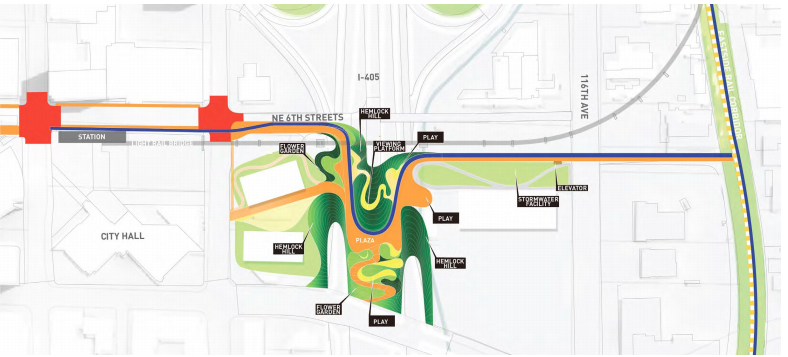
Inspiration
So what are good examples of existing spaces that fit the criteria above?
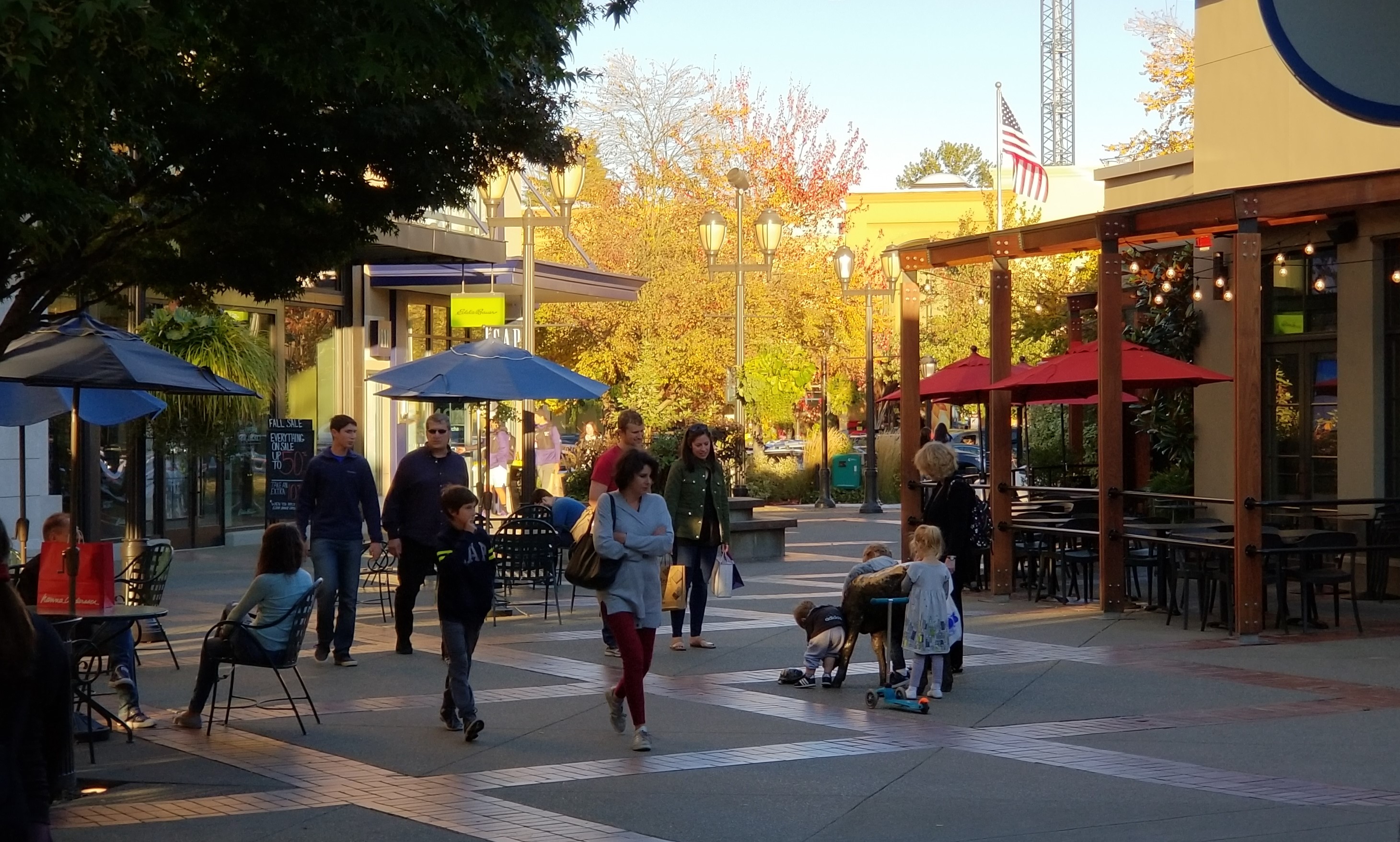
Take a look at this passage from Seattle’s University Village:
- Outdoor dining is available in a generously-sized seating area on the right.
- Public seating is on the left, and it can also be used for dining, especially if guests order from different restaurants.
- The wide open area in the middle is also free from motorized traffic and safe for children to play (as is evident).
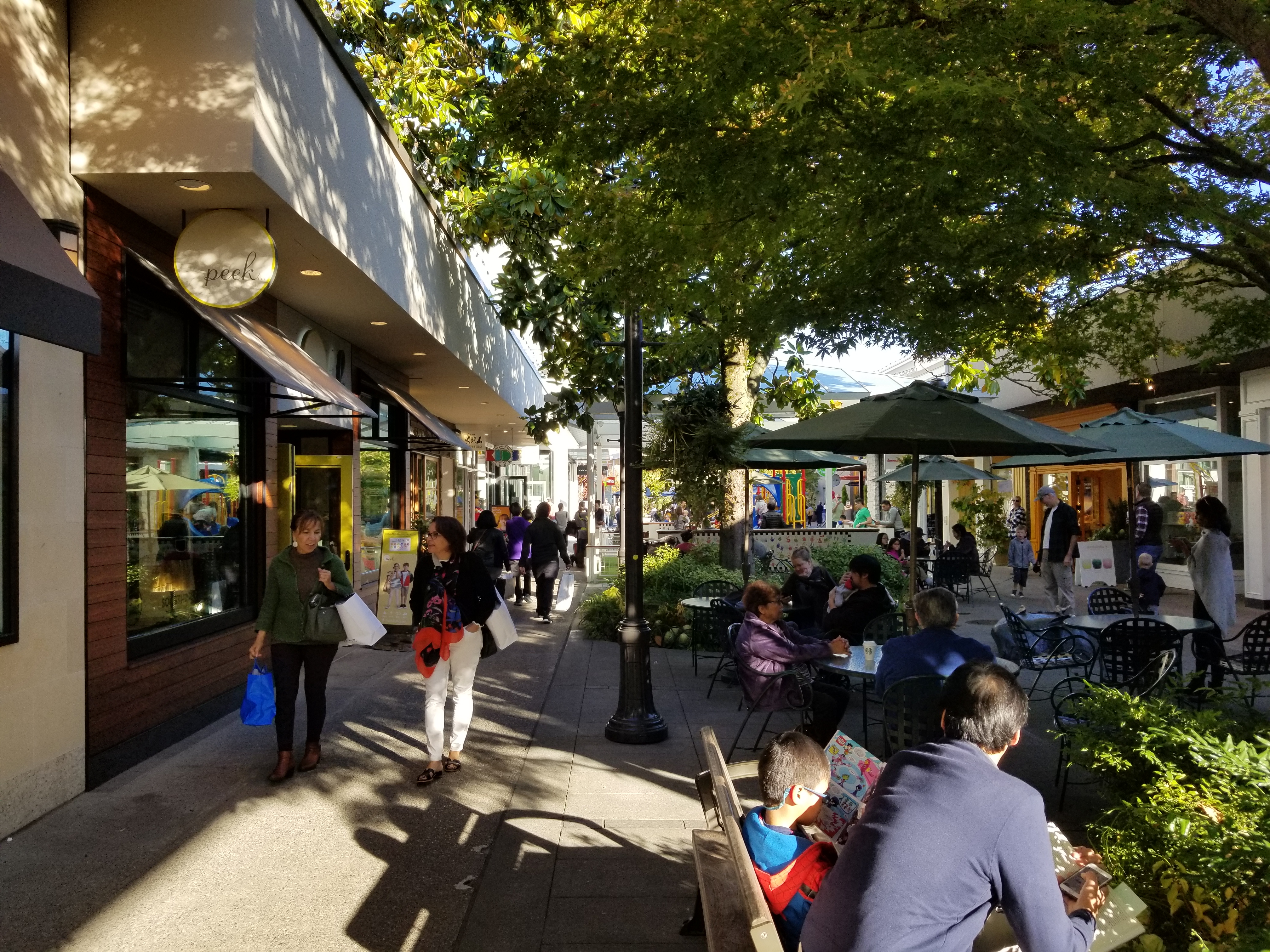
Here is another spot further down the same passage in University Village.
- Notice the proximity of the public seating to the retail space on the left. This makes it perfect for taking food or drinks and consuming them at the outdoor seating.
- It is also a great place to sit down and relax, read a book, or browse the web.
- The space is desirable for all ages, from the child in the foreground to the elderly further back.
- There is a small playground behind the tree, an important element in making the space useful for families.
Another important component is the coverage and width of retail space. To truly activate such a corridor, there should be close to 100% coverage of retail space.
By default, developers seek to provide larger spaces which command higher rents from bigger businesses. Incentivizing at least a few spots per block with smaller retail spaces can help in diversifying the mix of businesses, especially as it enables smaller businesses to start up there.
Again, here is an example from University Village:
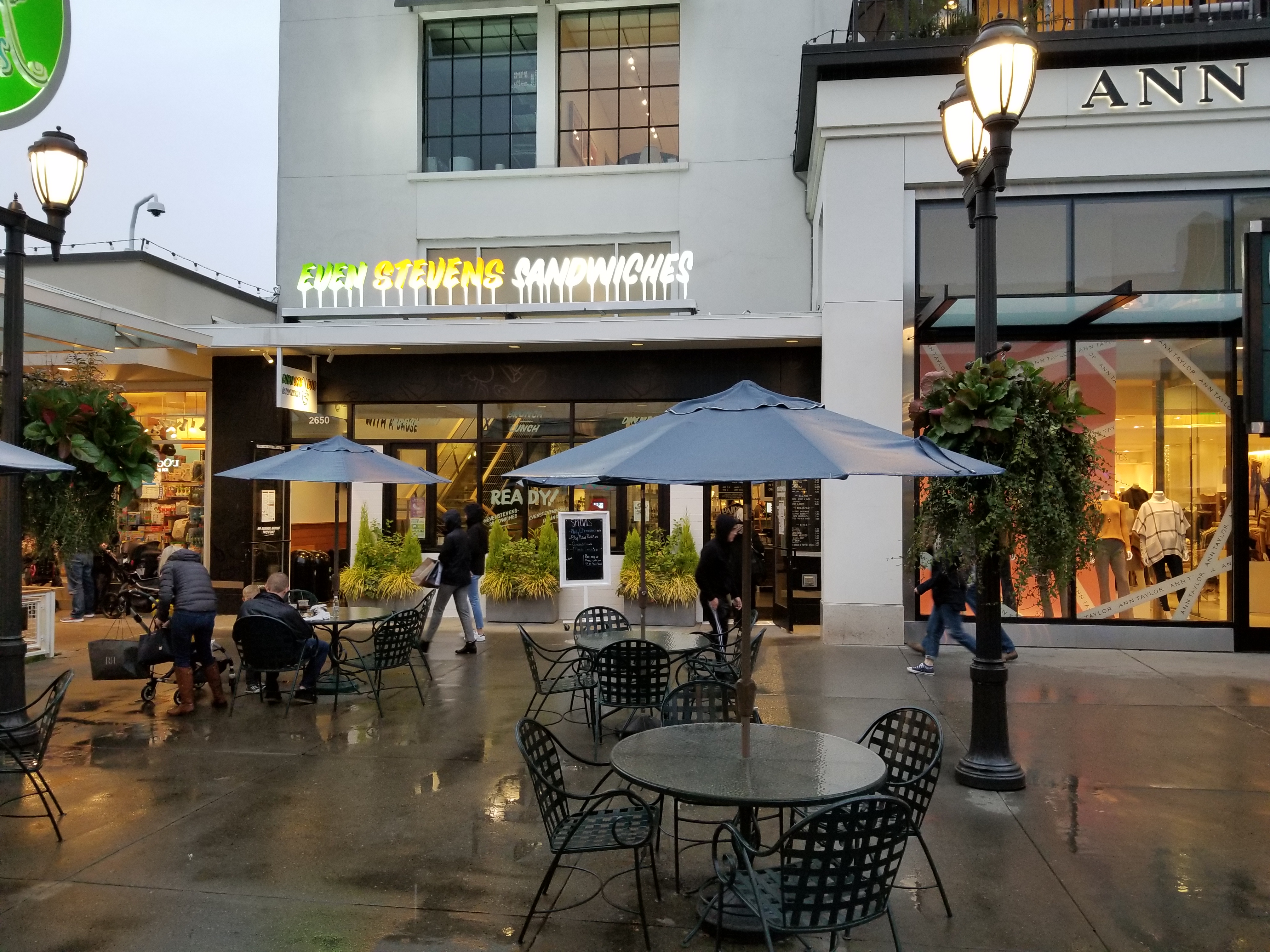
And from Main Street. The width of retail is one of the reasons it is so successful.

Grand Connection Design Proposals
So what are specific practices the city can incentivize developers to implement based on the above?
- Retail space
- Have near 100% coverage
- The more retail there is, the more reasons people will have to visit the area.
- One of the key metrics for success should be how activated the place is and retail is a strong year-round revenue-positive driver of activation.
- Retail also makes the edges of the public space “porous”, meaning accessible to people, and therefore the entire space more interesting.
- Provide both small and large retail spaces
- Incentivize developers to provide a percentage of retail spaces narrower than 30 feet as part of their overall retail frontage.
- Ultimately such a measure should make the entire retail space mix more valuable and be in the benefit of the developer.
- Have near 100% coverage
- Outdoor seating
- Designate areas for outdoor seating—public and private
- Private seating
- Retail seating spaces do not necessarily have to be immediately adjacent to a retail space. They could be in the middle of the corridor, but may require fencing or other demarcation.
- The Grand Connection plan should provide options for where such spaces can be located and how they can be separated.
- If the plan will be very prescriptive, its design can include the actual seating areas, planting strips, and other greenery.
- There should be access to electricity in those spaces regardless of their location (to provide for lighting, heating, A/V equipment, etc.).
- Retailers can choose the types of chairs, tables, umbrellas, and heating they will use.
- Public seating
- Should consist of both chairs/benches and tables.
- Can potentially be used by retail patrons from different establishments.
- This poses the question of why not make all seating public and shared, but enable restaurants to serve there.
- Greenery
- All public spaces include greenery, but when the quantity becomes sufficiently high that the place feels more like a park or garden, it changes fundamentally.
- One could divide public open spaces into parks and plazas depending on the percent coverage of greenery. From the two, parks are perhaps acceptable to a wider swath of the population.
- The examples above from the U Village show a more park-like atmosphere, rather than a plaza, despite being surrounded by retail. It appears to be a very effective combination.
- Grading
- NE 6th St is on an incline, so grading matters.
- A continuous grade on the corridor with designated flat seating areas may be preferable to having flat areas with stairs connecting them. It would also be more accessible.
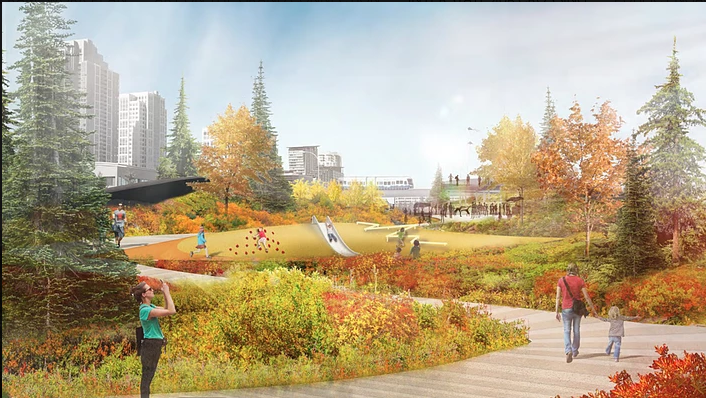
Seizing the Grand Connection Opportunity
We have a once in a lifetime opportunity to create a new center of the neighborhood, a place many people will identify with. The choices made now will persist for decades and will set the tone for the future development of Bellevue.
Let’s make the investments that will strengthen our community the most.

Anton Babadjanov
Anton has been living in the Pacific Northwest since 2005 and in Seattle since 2011. While building technology products during the day, his passion for urban planning and transportation is no less and stems from a childhood of growing up in the urban core of a small European city.

